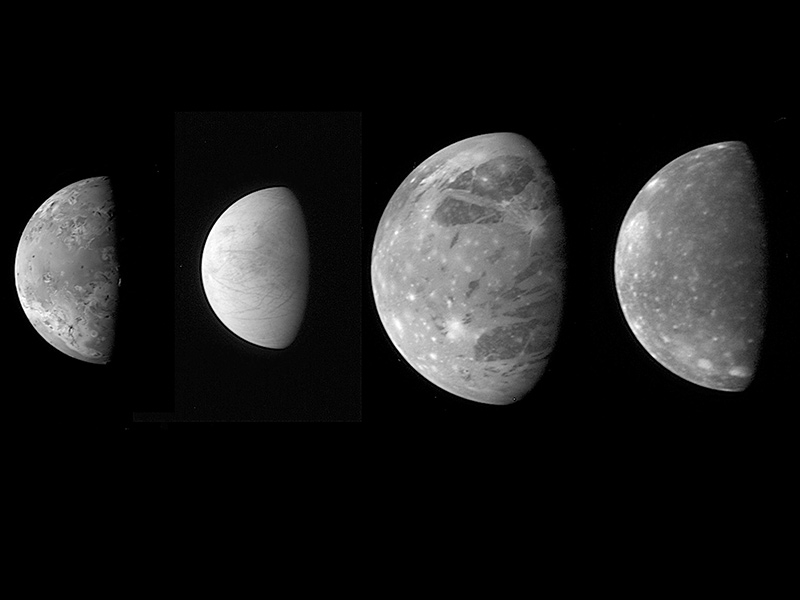-
Europa: Jupiter’s ocean world
Read now to access more details of Europa: Jupiter’s ocean worldIn the coming years, Jupiter’s moon Europa will be a focus for planetary exploration because of the tantalising possibility that it might harbour life. This article introduces you to this enigmatic moon and why space scientists and astrobiologists are excited about exploring it further.

-
The ocean of Jupiter’s moon Europa
Read now to access more details of The ocean of Jupiter’s moon EuropaAt over 3100 kilometres across, Europa is the fourth largest moon of Jupiter and the sixth largest moon in our Solar System, rivalling the size of Earth’s moon. Of interest to many scientists, space enthusiasts and science fiction authors is the potential for a vast, global ocean to exist below Europa’s outer icy shell; but why do we think there...

-
Europa’s icy shell
Read now to access more details of Europa’s icy shellJupiter’s moon Europa has a distinctive icy surface, with a network of cracks, ridges and chaotic terrain. These features are formed by powerful gravitational forces from Jupiter that reshape the moon’s landscape and offer clues about its geological activity. This article explains these features and the processes that underpin them.

-
Is there life on Europa?
Read now to access more details of Is there life on Europa?The potential for an ocean on Jupiter’s moon Europa opens up the possibilities of it being habitable for life. With missions due to visit the moon in the coming decade, it is an exciting time for astrobiologists. This article explores why Europa might be a target in the search for life, and what the potential might be of finding it there.

-
Exploring Europa
Read now to access more details of Exploring EuropaWe are at the beginning of an exciting new phase of Solar System exploration, in which Jupiter’s enigmatic ocean moon Europa will be front and centre. Here we look at what two upcoming missions hope to achieve and why this is important for space scientists and astrobiologists.

-
The ice-covered ocean worlds of the outer Solar System
Read now to access more details of The ice-covered ocean worlds of the outer Solar SystemWhat do we know about Jupiter's and Saturn's icy moons? Could there be life on them? This article explores what previous missions can tell us and what future missions hope to find out.

-
Exploring the icy moons
Read now to access more details of Exploring the icy moonsMark Fox-Powell is a Research Fellow in AstrobiologyOU. His research focuses on the potential habitability of the deep oceans of the ice-covered moons of the outer solar system. He discussed his career path and work with Ann Grand, Lecturer in Astrobiology Education.

-
Planetary Protection of Icy Worlds
Read now to access more details of Planetary Protection of Icy WorldsAs our understanding of life and its potential beyond Earth improves, attention is moving towards smaller bodies, including moons and dwarf planets in the outer regions of our Solar System. But how can we strike a balance between exploring these new worlds and ensuring they remain unspoilt?

-
A new mission to the icy moons of Jupiter
Read now to access more details of A new mission to the icy moons of JupiterIn April 2023, the European Space Agency launched the JUICE (JUpiter ICy Moons Explorer) mission. JUICE will explore the environment around Jupiter and study its three icy moons (Ganymede, Europa and Callisto). Could moons like these, orbiting giant gas planets, be habitable?

-
Space: to boldly, but cautiously, go.
Take part now to access more details of Space: to boldly, but cautiously, go.Space exploration is full of possibilities, especially when searching for signs of life. But the reality is complex. What lies behind the many decisions that have to be taken to design and run a space exploration mission?

-
Life Beyond Earth: The Big Debate
Watch now to access more details of Life Beyond Earth: The Big DebateA panel of Open University experts go head-to-head to debate whether life is more likely on Mars or on the icy moons of the gas planets.

-
Moons of our Solar System
Learn more to access more details of Moons of our Solar SystemIn this free course, Moons of our Solar System, explore the many moons of our Solar System. Find out what makes them special. Should we send humans to our Moon again?


Rate and Review
Rate this article
Review this article
Log into OpenLearn to leave reviews and join in the conversation.
Article reviews